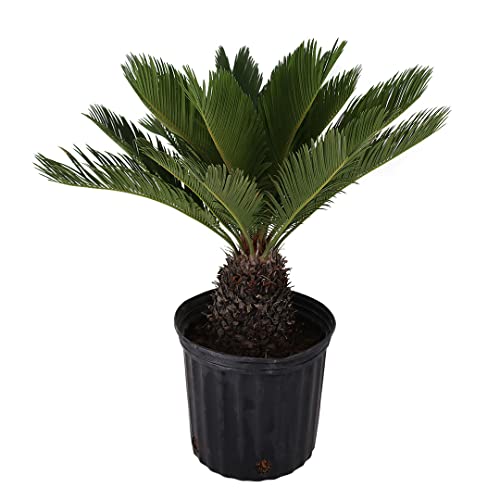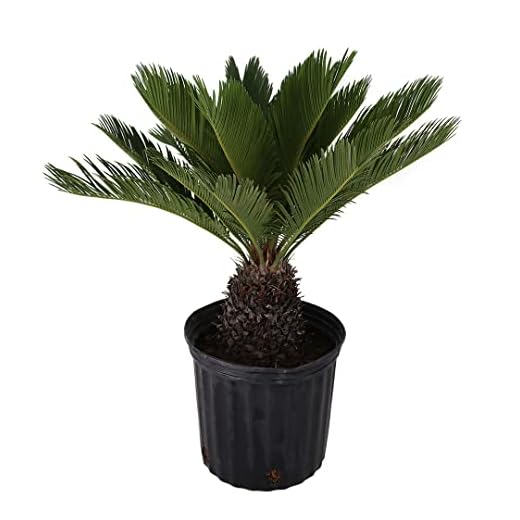

As an 8-year-old Scottish Fold with a keen interest in my well-being, I must share something crucial: specific plants can pose dangers to our furry companions. The plant in question contains compounds that can lead to serious health issues for our four-legged friends. Symptoms of ingestion may include vomiting, diarrhea, and lethargy, which can escalate into more severe conditions if left untreated.
To keep your home safe, it’s wise to avoid having this particular species around. If you suspect your pet has ingested any part of it, immediate veterinary attention is essential. Keeping a close eye on your surroundings and opting for pet-friendly greenery ensures a safer environment for your curious little explorer.
Incorporating non-harmful plants into your home not only enhances the aesthetic but also protects your beloved companion. Always research before bringing new greenery into your space, making informed choices that prioritize your pet’s health and happiness.
Are Sago Palms Dangerous to Felines?
These plants can pose serious risks to my furry friends. Ingestion of any part, especially the seeds and leaves, can lead to severe health issues.
Symptoms of distress include vomiting, diarrhea, and lethargy. More alarming signs can manifest as liver failure, which may require immediate veterinary intervention.
To ensure safety, it’s best to keep these greenery out of reach. If you suspect that a furry companion has nibbled on any part, contacting a veterinarian right away is crucial.
For those who love greenery, consider safer alternatives that are feline-friendly. Many plants can beautify a space without endangering our four-legged pals.
Understanding Plant Characteristics
These specimens, often admired for their unique appearance, are part of the Cycad family. They can grow up to several feet tall, featuring a stout trunk topped with a crown of arching, feathery leaves. The foliage is evergreen, providing year-round greenery. The leaves can be quite sharp, making them less suitable for curious paws.
Growth and Care
Thriving in warm climates, these plants require well-drained soil and plenty of sunlight. They don’t demand excessive watering, making them relatively low-maintenance. However, overwatering can lead to root rot, which can be detrimental to their health. Regular pruning of dead or damaged fronds promotes better growth and maintains their aesthetic appeal.
Reproductive Features
These specimens reproduce through cones, which emerge at the center of the plant. Male and female structures are distinct; the male produces pollen, while the female develops seeds after pollination. The seeds are highly valued but should be handled with care due to their harmful properties for certain animals.
Identifying Symptoms of Sago Palm Toxicity in Cats
If you suspect that your feline friend has ingested parts of a certain plant, watch for specific signs. Common symptoms include vomiting, diarrhea, and abdominal pain. These can manifest within hours of consumption.
Increased thirst and urination are also key indicators. If you notice your companion drinking excessively or using the litter box more frequently, it’s a cause for concern.
Another alarming symptom is lethargy. If your usually playful buddy seems unusually tired and uninterested in activities, it’s important to take note.
Seizures or tremors are severe reactions that require immediate veterinary attention. If you observe any neurological symptoms, don’t hesitate to seek help.
Additionally, jaundice can occur, characterized by a yellowing of the skin or eyes. This indicates liver distress and should be treated as an emergency.
Always consult a veterinarian if you suspect ingestion. Quick action can make a significant difference in recovery. Remember, prevention is the best approach–ensure that harmful plants are out of reach. Stay safe!
What to Do If Your Cat Eats Sago Palm
If I munch on a piece of that plant, you should act fast. First, don’t panic. Stay calm and assess the situation. If you suspect I’ve eaten any part, check for symptoms like vomiting, diarrhea, or lethargy. These signs might appear within a few hours.
Next, contact your veterinarian immediately. Provide them with details about what I may have consumed and any symptoms I’m showing. They might ask for specifics, so be ready with that information. They might recommend bringing me in for an examination or suggest home care measures.
Do not induce vomiting unless instructed by a vet. Some substances can do more harm if brought back up. If possible, take a small sample of the plant with you to the clinic; it helps the vet understand what they’re dealing with.
While waiting for advice, keep me comfortable and monitor my behavior. Avoid offering food or water until the vet gives the green light. Quick action can make a difference, so don’t hesitate to seek professional help!
Preventing Exposure to Dangerous Plants
Keep hazardous flora out of reach. If you have a green thumb, consider replacing harmful species with safer alternatives. This can help create a pet-friendly environment.
Safe Plant Alternatives
- Bamboo Palm
- Spider Plant
- Boston Fern
- Areca Palm
- Prayer Plant
Clearly label any plants in your space. If you’re unsure about a specific plant, research its safety for furry companions. Use apps or websites dedicated to pet safety for quick checks.
Environmental Control
- Designate a cat-free zone in your home, especially around plants.
- Utilize barriers, like gates, to keep curious paws away from potentially harmful greenery.
- Regularly inspect your home for any fallen plant debris that could attract attention.
Maintain a balanced diet for your feline friend to minimize their curiosity about non-food items. Incorporating the best hairball food for cats can help manage their grooming habits and reduce the chance of them nibbling on unsafe plants.
Common Myths About Sago Palms and Pet Safety
Many believe that certain indoor plants are completely safe for furry friends, but that’s not the case with these plants. One myth suggests that only the seeds are harmful, while the leaves are harmless. In reality, all parts of the plant contain dangerous compounds that can affect health.
Another misconception is that older or larger animals are more at risk. Actually, any pet can experience adverse effects regardless of age or size. Young ones might be more curious, but adults can also suffer if they ingest any part of the plant.
Misunderstanding Symptoms
Some think that symptoms will show immediately after ingestion. However, signs of distress may take hours or even days to appear, which can lead to delayed treatment. Being vigilant and recognizing subtle changes in behavior is key to ensuring well-being.
Assuming All Plants Are Safe
Many pet owners assume that if a plant is found in pet stores, it must be safe. This is not a reliable indicator. Always research before bringing any greenery into your home, as some plants commonly sold can pose risks.
Alternatives to Sago Palms for Pet Owners
If you’re looking for safe greenery that won’t harm your furry friends, consider these options:
- Ponytail Palm: This hardy plant thrives in various conditions and is non-harmful to pets.
- Bamboo Palm: A popular choice for indoor spaces, it adds a tropical feel without any risk to your companions.
- <strong Spider Plant: Known for its air-purifying qualities, this plant is safe and easy to care for.
- Ponytail Plant: With its unique appearance, it provides a stunning visual while being safe for animals.
- Areca Palm: Great for humid environments, this palm is both beautiful and non-toxic.
For those looking to maintain cleanliness around plants, consider using a best pressure washer for gutters to keep your outdoor areas tidy.
By choosing these alternatives, you can create a pet-friendly environment that is both safe and aesthetically pleasing.
Consulting Your Veterinarian About Plant Safety
Always reach out to your veterinarian if you suspect that your furry friend has ingested any part of a hazardous plant. They can provide tailored advice and treatment options based on your pet’s specific situation.
It’s beneficial to keep a list of household plants and share it with your vet. This helps them assess potential risks and offer guidance on maintaining a safe environment for your pet.
During regular check-ups, discuss any changes in your pet’s diet or behavior. If your human companions bring new plants into your home, alert your veterinarian to ensure they are safe.
In case of emergencies, having the contact information of a local animal poison control center is helpful. They can offer immediate assistance if your pet has consumed a dangerous plant.
| Contact Information | Details |
|---|---|
| Veterinarian | Your vet’s name and phone number |
| Animal Poison Control Center | Phone number and website |
Monitoring your companion for any unusual symptoms after exposure to a questionable plant is crucial. If you notice anything concerning, contact your veterinarian immediately for further evaluation.
FAQ:
Are sago palms safe for cats?
Sago palms are not safe for cats. They contain a toxic compound called cycasin, which can cause severe health issues if ingested. Symptoms of poisoning in cats may include vomiting, diarrhea, lethargy, and even liver failure in serious cases. It’s crucial to keep sago palms out of reach of pets to prevent any accidental ingestion.
What should I do if my cat eats a sago palm?
If you suspect that your cat has eaten any part of a sago palm, it’s important to act quickly. Contact your veterinarian immediately for advice. They may recommend bringing your cat in for examination and treatment. Early intervention can significantly improve the chances of recovery.
How can I tell if my cat is suffering from sago palm poisoning?
Signs of sago palm poisoning in cats can vary, but common symptoms include vomiting, diarrhea, abdominal pain, excessive drooling, and weakness. In more severe cases, your cat may show signs of liver failure, such as jaundice (a yellowing of the skin and eyes). If you notice any of these symptoms after your cat has been around a sago palm, seek veterinary care promptly.
Are there any safe alternatives to sago palms for my home?
Yes, there are several safe plant alternatives that can add greenery to your home without posing a risk to cats. Consider plants like spider plants, Boston ferns, or cat grass, which are non-toxic and safe for pets. Always research the safety of any plant before bringing it into your home, especially if you have cats or other pets.








